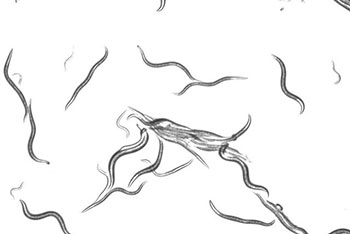
Author: Brenda Bass
 It is important to know when to sound the alarm and when to avoid calling the police on your housemate rather than an intruder.
It is important to know when to sound the alarm and when to avoid calling the police on your housemate rather than an intruder.
Our cells face a similar task—is the invader a virus or just something that looks like a virus? To make matters worse, ancient viruses have left little pieces of themselves all over our genomes. Some of these ancient relics form a molecule called double-stranded RNA (dsRNA) that looks just like dsRNA made by a virus.
Fortunately, an enzyme called an ADAR marks our own dsRNA so that it can’t be confused with viral dsRNA. This subtle recognition is essential, because triggering a viral response in the absence of a viral invader can be deadly. In fact, babies born with defective ADAR sometimes have a devastating disease called Aicardi-Goutières syndrome. The body thinks it has a virus when it doesn't, and the baby’s antiviral pathways attack the newborn’s own organs.
Research from University of Utah Health shows that ADARs do the same things in a more primitive animal, the microscopic nematode worm known as Caenorhabditis elegans. Recently published in Genes & Development, their investigation demonstrates one way in which cells distinguish friend from foe.
“We didn’t even know this was an issue until about five years ago,” says Brenda Bass, Ph.D., distinguished professor of Biochemistry at U of U Health, referring to the question of defining self vs. non-self. During that time, it had been discovered that ancient viral DNA trapped in cellular genomes is sometimes transcribed, posing a dilemma to the cell. Bass, also the study’s senior author, investigated the phenomenon with first author and graduate student Daniel Reich and postdoctoral researcher Katarzyna Tyc, Ph.D.
Ordinarily, C. elegans defend against invading viruses by chopping viral dsRNA into small pieces. Those snippets, called small interfering RNAs (siRNAs), bind to complementary sequences in viruses, targeting them for destruction. In effect, the worms’ defense is to turn the virus against itself.

Reich’s initial inquiry that ADARs have something to do with it. In worms without ADARs, cells attacked their own dsRNAs as if they were viral. Sequencing demonstrated that dsRNAs from hundreds of worm genes were chopped into siRNAs. Then, the siRNAs targeted their corresponding genes for destruction.
When the worms’ immune response does not function properly, it has devastating consequences. “siRNAs even destroyed important RNAs that C. elegans need to live and reproduce normally,” says Reich.
ADARs distinguish “self” from “non-self” by altering the chemical makeup and distorting dsRNA. The modification is sufficient to set cellular dsRNA apart from viral dsRNAs and signal to cellular defenses to stay away.
The modified segments are enriched with those little pieces of ancient viruses that are scattered throughout the cell’s DNA. “We found that ADARs modify dsRNA from repetitive elements, remnants of ancient viruses in our own genome that make dsRNA,” says Reich.
The investigators proved that viral remnants are the culprits by using the precision DNA editing tool, CRISPR, to remove the segments of worm genes that are preferentially modified by ADARs. Genes missing these segments no longer formed dsRNA, and therefore were never inappropriately treated like a viral invader.
Despite differing approaches, this work shows that ADARs do the same thing in invertebrates as they do in mammals: they prevent cellular dsRNAs from accidentally triggering the immune response.
That seems to make a good end to the story but in science, things are rarely as they appear. Bass points out that there are clues that the worms’ immune response is more complex. There is evidence for an additional response to viral invasion, and ADARs also appear to keep this second pathway at bay when viruses are not present. ADARs are conserved from worms to humans, so it could be that this additional, mysterious pathway is, too.
# # #
Reich, Tyc, and Bass’s research is supported by the National Institutes of Health and was published as “C. elegans ADARs antagonize silencing of cellular dsRNAs by the antiviral RNAi pathway” in Genes & Development.
Bass is also an adjunct professor in the Department of Human Genetics and a member of the Huntsman Cancer Institute.